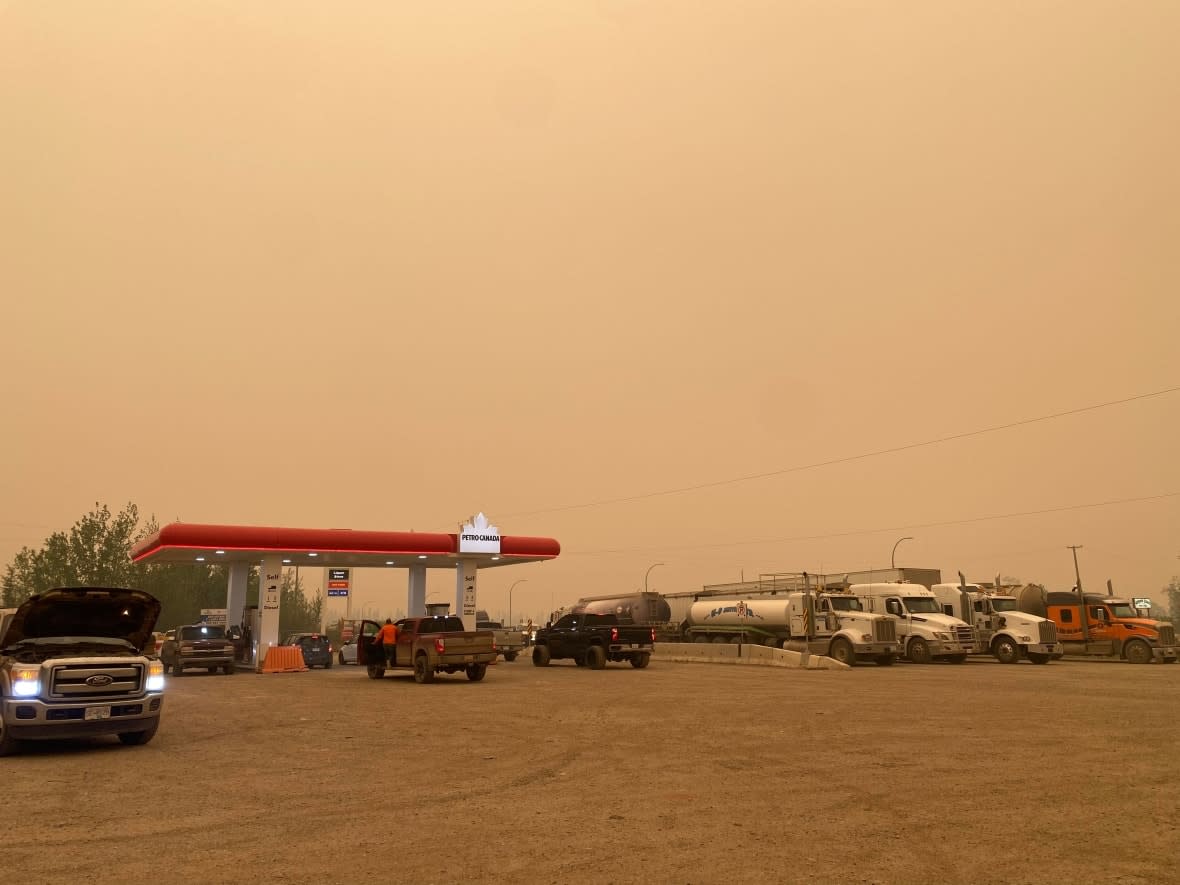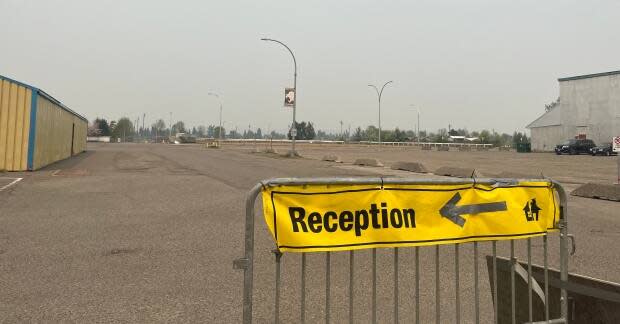Fort St. John residents watch and wait as wildfires burn near city

Calmer winds are helping crews hold off two out-of-control wildfires outside Fort St. John in northeastern British Columbia, a day after the city of 21,000 was told to prepare for a possible evacuation amid what one resident called scenes of "controlled chaos.''
Patrick Patterson says there was a sense of panic among some residents Monday as winds reaching 61 kilometres per hour blew dark smoke over the city, around the time the evacuation alert was issued.
Winds around the city have calmed to 15 kilometres per hour, but the operations director for the B.C. Wildfire Service (BCWS) says unseasonably warm and dry weather continues to pose "very challenging'' conditions for crews fighting the overlapping Red Creek and Stoddart Creek fires.
Cliff Chapman told a news briefing the flames are about 20 to 25 kilometres from Fort St. John.
Major fires surrounding Fort St. John
Chapman says an abundance of black spruce, a timber that can fuel extremely fast fire spread, forced firefighters to pull out of some positions Monday, with some fronts moving up to 12 kilometres in a 12-hour period.
The BCWS says 50,000 hectares of land has been burned in the province so far this year, several times higher than the 10-year average of 11,000 hectares at this point in the season.
Hannah Swift, a fire information officer, said forecasters had thought winds would spread the Stoddart Creek fire southeast — towards Fort St. John — on Monday night, but gusts blew the fire southwest instead, something she said was good news for residents.
"Today [Tuesday] on site, we actually do have a bit of a reprieve," she told a news conference. "We have much lower temperatures than we've seen over the last week.
"By Wednesday and into Thursday, we do have an upper ridge tracking just north of B.C. It's going to bring back those abnormally hot and very dry weather conditions to the region."
WATCH | Farm operator says she had to move horses out after alert:
Fort St. John still on alert, hundreds out of their homes
New evacuation orders and alerts were issued overnight, while more than 21,000 people in the city of Fort St. John remain on evacuation alert due to what officials called "significant and extreme" fire risk.
Two wildfires of note burning near Fort St. John — Stoddart Creek and Red Creek — are considered out of control, as are the Cameron River and Donnie Creek wildfires, also in the northeast.
Shortly after midnight Tuesday, the Peace River Regional District expanded its evacuation order for the Donnie Creek/Tommy Lakes region, and alerts were also expanded to more properties.
WATCH | Fort St. John mother shares struggle of waiting for evacuation order:
In a news conference Tuesday, emergency official Mike Watkins said he estimated 50.1 per cent of the entire district was either on evacuation order or alert, and no further changes to the orders or alerts were expected.
Evacuation orders mean people must leave their properties immediately, while alerts mean people should be prepared to leave at a moment's notice, gathering essential items, including medication, identification and supplies for pets.
Open burning will also be banned provincewide starting Thursday, the BCWS said.
B.C.'s most visible fires on Tuesday
City of Fort St. John urges residents not to panic
In Fort St. John, approximately 600 kilometres northwest of Edmonton and 1,200 kilometres north of Vancouver, information officer Ryan Harvey said it is important for residents to be prepared but not to panic.
"There's a bit of smoke but it's not as bad as yesterday," he told CBC News on Tuesday morning. "We can see the sky."
Harvey said there were long lines for gas and supplies Monday as people prepared for the worst. But he emphasized that at this point emergency officials are not expecting to issue an evacuation order for the entire city.
Several businesses have closed as a precautionary measure and the Peace River North school district has cancelled classes for several rural schools for the week due to evacuation orders but schools within the city of Fort St. John remain open.
B.C. Hydro says it had suspended work on the Site C dam project, located a few kilometres southwest of the city, as a precautionary measure on Monday. On Tuesday afternoon, a spokesperson told CBC News that crews would return to work, but the Crown corporation was prepared to transport workers away if needed.
Evacuees now being directed to Prince George
Harvey said the city has already taken in "several hundred" evacuees from outlying communities and First Nations but because of the evacuation alert people in need of lodging are now being directed further south.

After emergency support services in nearby Dawson Creek "filled up rather quickly," Harvey said, people are now being asked to drive to Prince George, about 430 kilometres south of Fort St. John, if they need a place to stay. They can register at the CN Centre at 2181 Ospika Blvd or by calling 778-675-3735.
The Peace River Regional District says people who do not need lodging can also register at the Chetwynd Recreation Centre at 4552 North Access Rd. or by calling 250-556-4173.
Lessons from 2017
Should Fort St. John residents be told to leave their homes, it would be one of the single largest evacuation orders in the province in years, comparable to 2017 when the Cariboo Regional District ordered more than 30,000 residents to leave their communities due to encroaching wildfires.
About 10,000 of those evacuees made their way to Prince George, where the city set up an emergency support centre and lodging at the College of New Caledonia where, for several weeks, people camped and slept on gym floors.
Emergency programs manager Tanya Spooner said since then, the city has changed its approach and now aims to place evacuees in hotel rooms or other lodgings.
She said at this point, the city has enough hotel rooms to accommodate any evacuees and her team is preparing for a possible worst-case scenario.
"We will be able to take people in Prince George," she said.
"I can't tell you exactly where they're going to stay ... but I can tell you that they're going to be safe."


